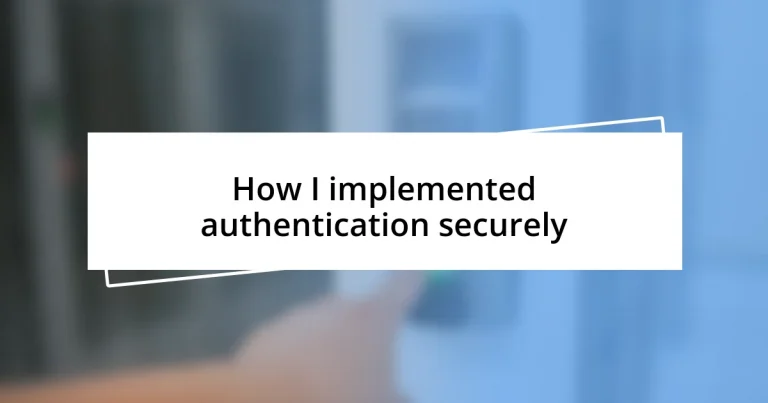Key takeaways:
- Implementing Multi-Factor Authentication (MFA) significantly enhances security by adding extra layers to the login process, fostering user confidence.
- Utilizing secure password storage techniques, such as bcrypt for hashing, is crucial to protect user data from breaches.
- Regularly testing authentication security and staying updated with trends and emerging technologies ensures robust defense against potential vulnerabilities.
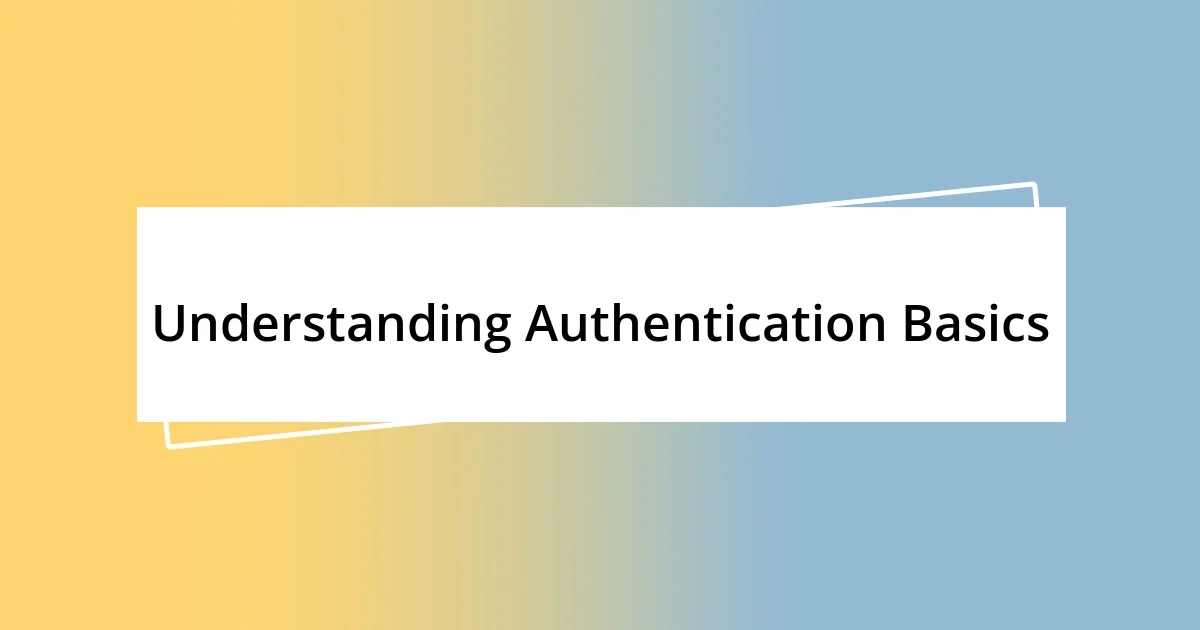
Understanding Authentication Basics
Authentication is essentially the process of verifying who someone is before granting access to systems or data. It’s intriguing to think about how often we unknowingly engage in this process—like when we log into our email or use a secure app. Have you ever considered how much you rely on this simple yet vital security measure?
When I first started working in cybersecurity, I vividly remember my reactions to various authentication methods. I was both fascinated and overwhelmed by the options available: passwords, biometrics, and even two-factor authentication (2FA). Each method has unique strengths and weaknesses, making the choice feel almost like a personal journey through a maze of security features.
In practice, I’ve learned that strong authentication goes beyond just using a complex password. It’s about creating a layered defense to protect sensitive information. Have you ever experienced the frustration of forgetting a password? Those moments reinforced my belief that the most secure systems also need to be user-friendly, balancing security with convenience.
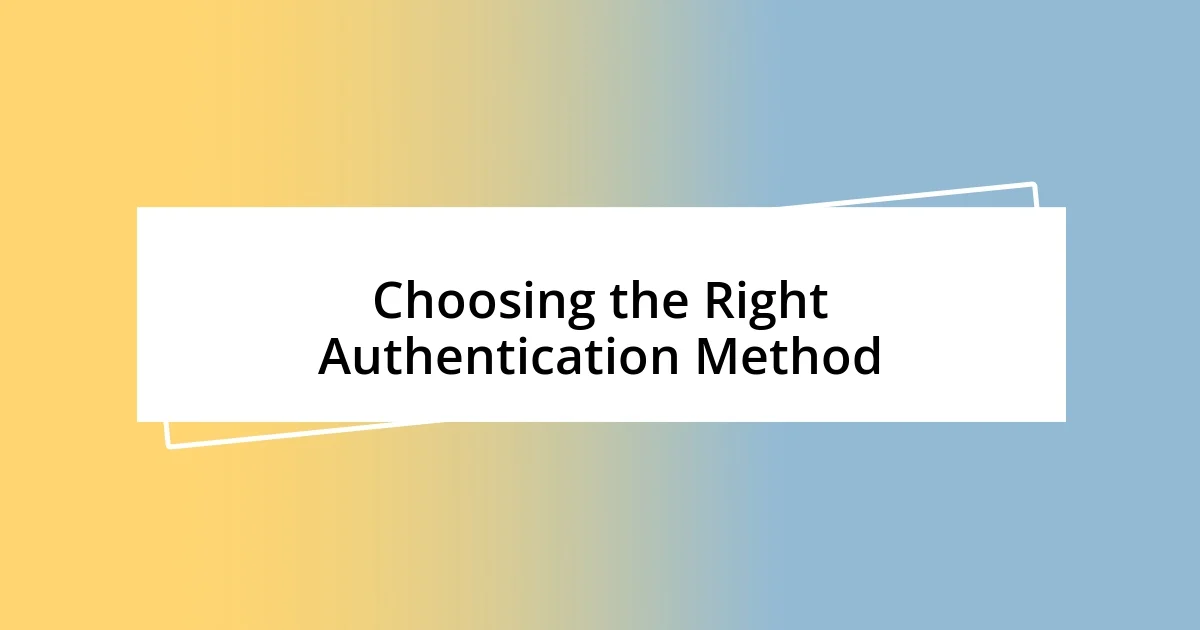
Choosing the Right Authentication Method
Choosing the right authentication method can feel a bit daunting, especially with so many options available. I remember sitting in a meeting where a heated debate broke out over whether to employ biometric authentication for our application. The room was split: some argued for its convenience and security, while others were concerned about privacy issues and the potential risks if biometrics were compromised. It’s moments like these that illustrate the importance of thoroughly evaluating not just the method, but the specific context in which it will be used.
As I explored various authentication techniques, I found that different methods catered to different needs. For instance, while passwords are the most common, they can be easily forgotten or phished. Meanwhile, two-factor authentication offers an extra layer of security, but it can sometimes feel cumbersome. The key is to align the authentication method with user needs and the sensitivity of the information being protected. I often ask myself: what level of security are we aiming for, and will it make the user’s experience better or worse?
In my experience, blending methods—such as combining strong passwords with 2FA—was the best route we could take for a balanced approach. It’s like choosing the right ingredients for a recipe; the flavors need to harmonize without overwhelming the palate. After all, users should feel secure and not frustrated when accessing their accounts.
| Authentication Method | Pros |
|---|---|
| Password | Widely understood and easy to implement |
| Biometrics | Convenient, unique to individual users |
| Two-Factor Authentication (2FA) | Enhanced security, reducing risk of unauthorized access |
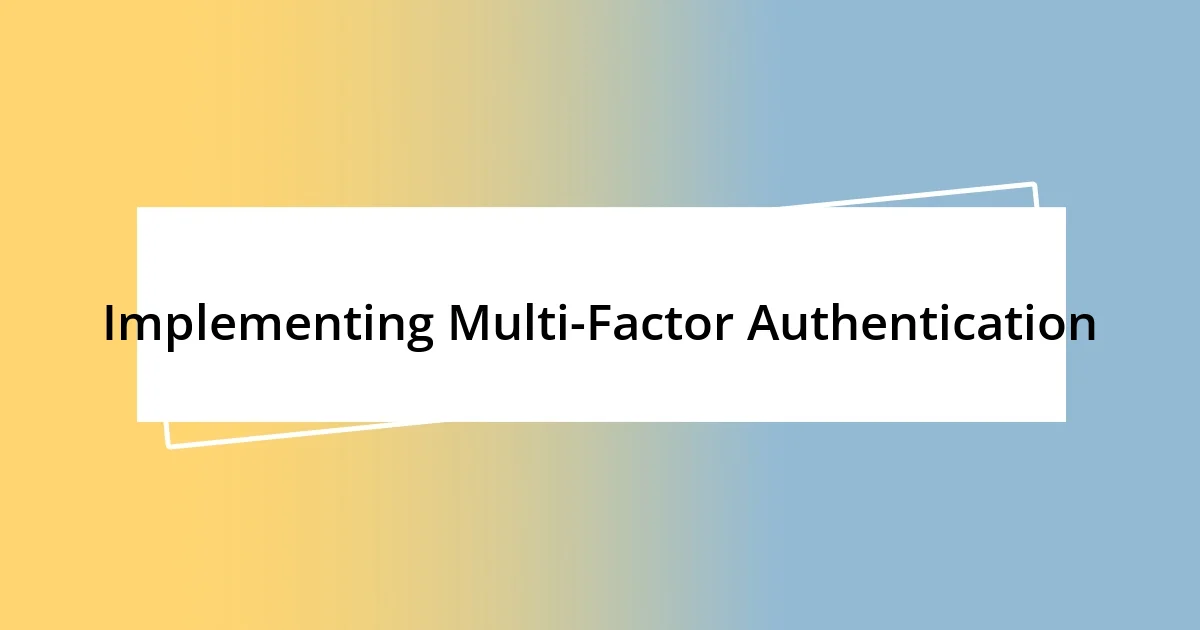
Implementing Multi-Factor Authentication
Implementing multi-factor authentication (MFA) has been a game changer for me in the cybersecurity space. I remember the day we finally decided to roll out MFA for our application; it felt like equipping our users with an invisible shield. The increased confidence our users expressed after the implementation was palpable. It’s fascinating how just a few extra steps can turn a simple login into a robust security fortress.
When considering MFA, I found it valuable to choose methods that were straightforward and user-friendly. Here’s what I focused on in my implementation:
- TOTP (Time-based One-Time Passwords): Users appreciated having the option of receiving a password via an app like Google Authenticator. It felt secure yet accessible.
- SMS Authentication: While convenient, we were careful with this method due to vulnerabilities regarding interception. I’ve seen its effectiveness balance with its risks.
- Email Links: Sending a verification link via email worked well initially, but I noted how users sometimes overlooked or mistrusted these messages.
Ultimately, the user experience was at the forefront of our approach; I wanted everyone to feel that these additional steps were worth the extra layer of safety.
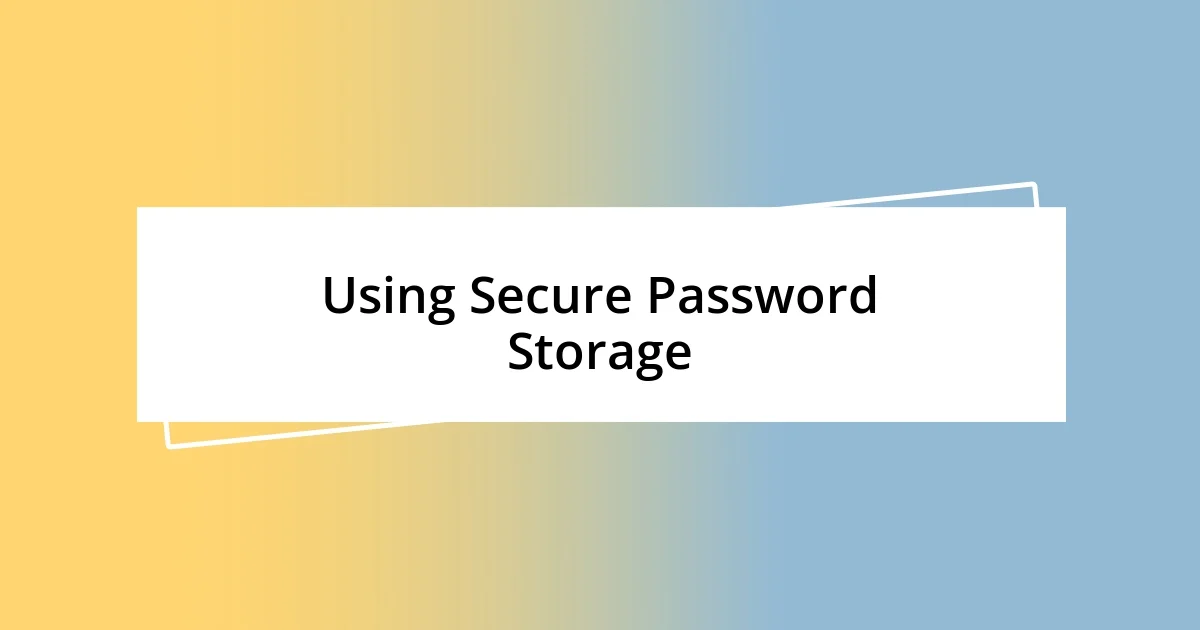
Using Secure Password Storage
Using secure password storage is a cornerstone of protecting user data. I remember the first time I dived into hashing algorithms; it’s one of those moments where you realize how critical it is to handle passwords properly. Instead of storing passwords in plain text, I opted for bcrypt, which not only hashes passwords but also adds a salt—a unique value for each password—making it harder for attackers to exploit. Do you ever think about what it would mean if a single data breach exposed millions of plain text passwords? It’s a daunting thought.
The complexity of the hashing process can feel overwhelming initially, but I found that taking the time to understand it pays off significantly. I often remind my team that using strong algorithms isn’t just a technical requirement; it’s a commitment to user security. When we implemented password hashing, it felt like lifting a weight off our shoulders—knowing that even if attackers managed to breach our database, they would only find indecipherable strings instead of user credentials.
Furthermore, regularly updating our password storage practices became a priority. Adopting new versions of hashing algorithms as they emerge is essential. I recall discussing this with a colleague who mentioned how their old systems became vulnerable simply because they didn’t evolve. It made me wonder: how many organizations risk their users’ security by neglecting such updates? For me, it’s a non-negotiable part of building a trustworthy platform.
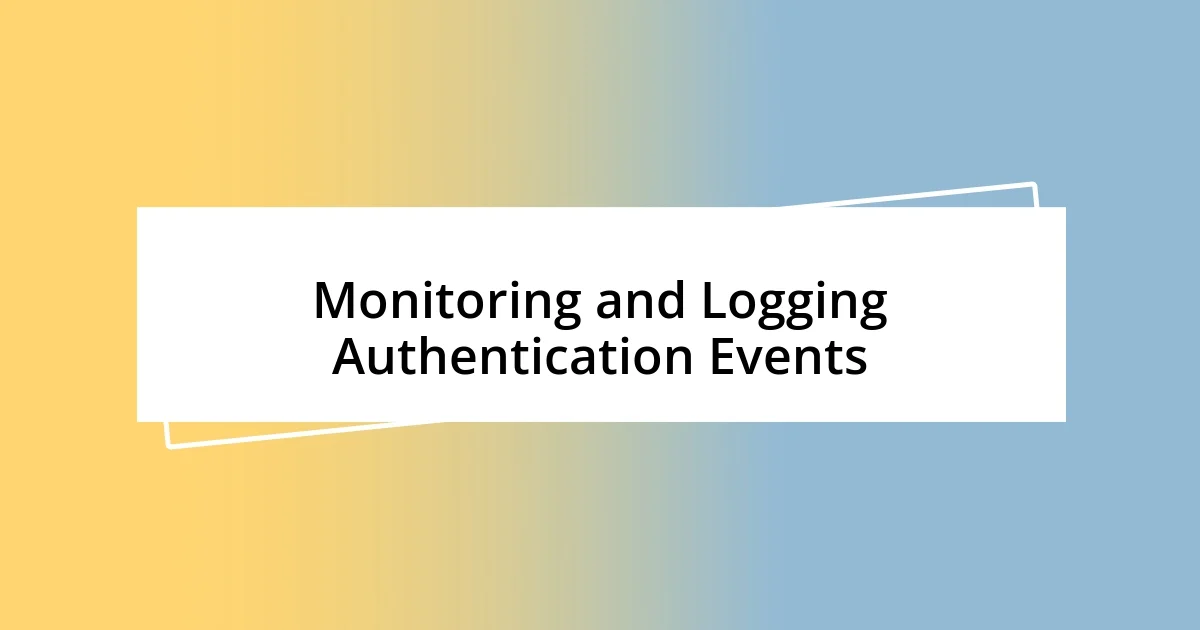
Monitoring and Logging Authentication Events
When it comes to monitoring and logging authentication events, I’ve learned that having a clear view of user activity is essential for maintaining security. Early on in my career, we set up a comprehensive logging system that captured every login attempt, whether successful or failed. I was surprised to find how much insight these logs provided; it felt almost like having a security camera in the digital world. Can you imagine what it would be like to track patterns over time? I remember spotting unusual login attempts and realizing they were hints pointing to potential breaches before they could escalate.
To make the logs more actionable, I implemented real-time alerts for abnormal behaviors, such as multiple failed authentication attempts. I can still recall the adrenaline rush that came when an alert pinged my phone during a late-night troubleshooting session. It reminded me how critical it is to stay one step ahead of any threat. These proactive measures offered not only peace of mind but also a powerful layer of defense, helping my team act swiftly to mitigate risks before they could spiral out of control.
One approach that has truly enhanced our security posture is correlating authentication logs with user context—like geographic locations and device types. I remember a specific incident where we noticed repeated login attempts from an unfamiliar location. By cross-referencing that data with our user profiles, we discovered an account that wasn’t just breached; it was compromised through phishing, which was a harsh lesson for all of us. It’s moments like these that make me appreciate the intricacies of monitoring, as they underline how crucial it is to not just collect data but to analyze and understand it deeply.
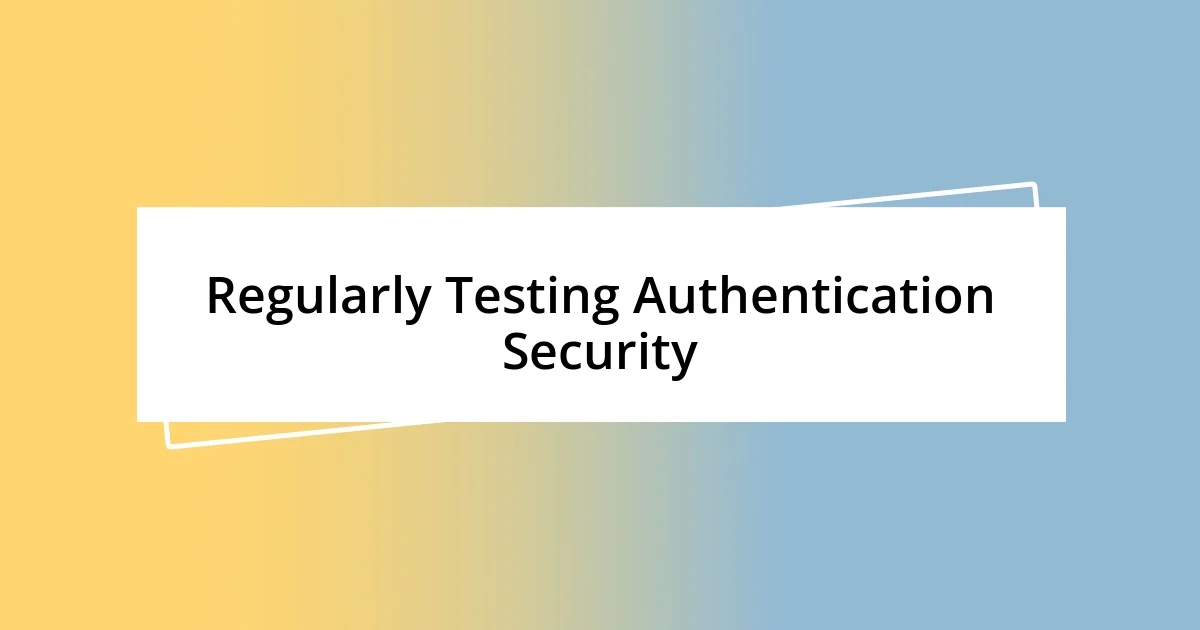
Regularly Testing Authentication Security
Regularly testing authentication security is an essential practice that I’ve embraced throughout my career. I vividly recall a time when I organized a mock penetration test for our authentication system, inviting ethical hackers to probe for vulnerabilities. The excitement was palpable as we discovered gaps we hadn’t anticipated, and I felt a mix of relief and urgency—realizing that these findings could have exposed us to significant risks if left unchecked. It made me wonder: how often are organizations wading through their systems without critically assessing their defenses?
I’ve also come to appreciate the value of automated security testing tools that can regularly evaluate our authentication mechanisms. Engaging with these tools, I often feel a sense of reassurance, knowing that our systems are under continuous scrutiny. I remember when one of these tools flagged potential weaknesses in our login process, leading us to enhance our multi-factor authentication. That experience reinforced my belief in diligent testing: it’s not just about identifying vulnerabilities; it’s about fostering a culture of security awareness within the entire team.
Additionally, I’ve learned that including all team members in testing exercises can unveil fresh perspectives. Recently, when we conducted a vulnerability assessment, I encouraged everyone to bring their unique insights to the table. One junior developer proposed a user-centric testing method that ultimately uncovered oddities in our user interface that could confuse users. It reminded me of the collaborative nature of security: every voice matters, and each testing session is an opportunity to strengthen our defenses. Are we truly doing enough to engage everyone in these crucial exercises? I often find that inclusivity breeds creativity and resilience in maintaining our authentication security.
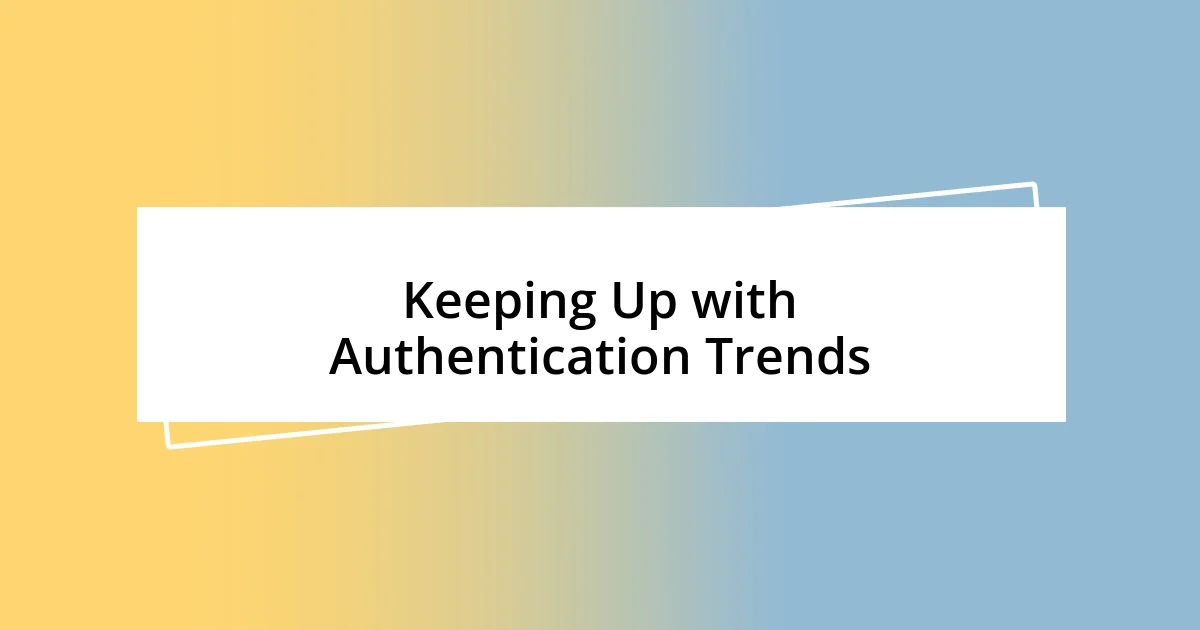
Keeping Up with Authentication Trends
Keeping up with authentication trends is something I find vital in our ever-evolving digital landscape. I still remember the day when biometric authentication began to catch my eye. Attending a tech conference, the presenter demonstrated facial recognition technology that was not only surprisingly accurate but also incredibly user-friendly. It sparked a thought: as we embrace innovative methods, are we also prepared for the ethical implications that come with them?
One of my most insightful experiences occurred when my team introduced passwordless authentication. At first, I was skeptical—could it really enhance security while simplifying user experience? Yet, seeing the enthusiasm during our rollout was exhilarating. Users expressed relief at no longer remembering complex passwords. This shift made me realize just how essential it is to balance security with user convenience. Are we listening to users’ needs while implementing these trends?
Engaging with industry communities helped me stay on top of emerging technologies. I fondly recall a vibrant discussion I had with fellow professionals about decentralized identity solutions. The potential these technologies hold to give users more control over their data is thrilling. As we move forward, I often ponder: are we ready to adapt our approaches to align with this shift towards decentralization? Staying ahead in authentication isn’t just about technology—it’s about understanding the ethics and user experience that accompany these advancements.












